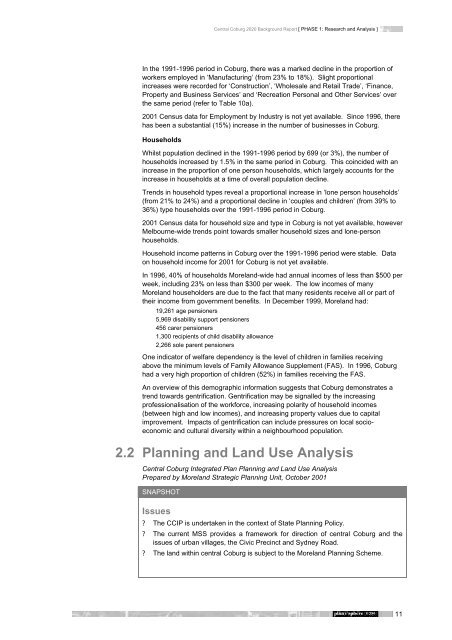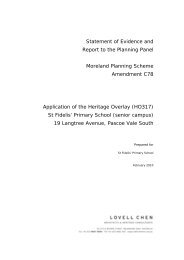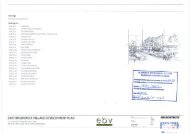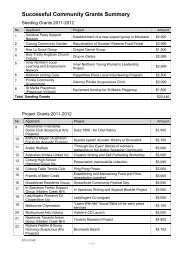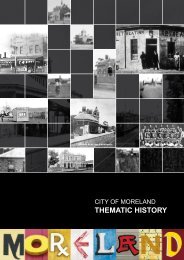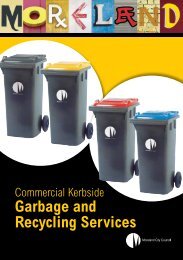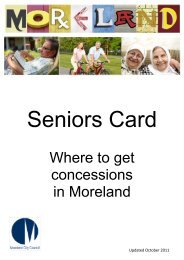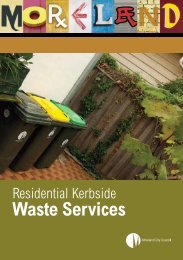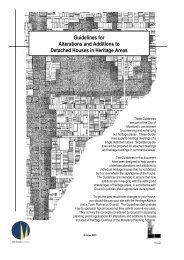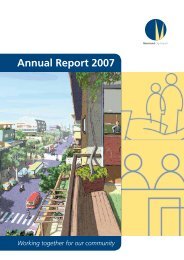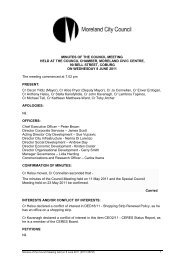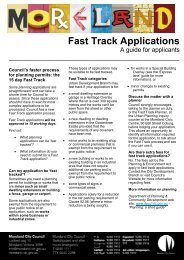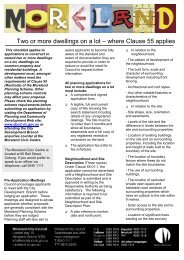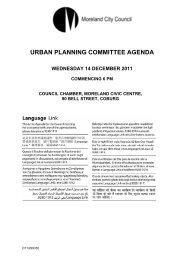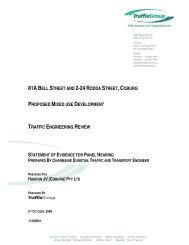Local Planning Policy Framework - Moreland City Council
Local Planning Policy Framework - Moreland City Council
Local Planning Policy Framework - Moreland City Council
You also want an ePaper? Increase the reach of your titles
YUMPU automatically turns print PDFs into web optimized ePapers that Google loves.
Central Coburg 2020 Background Report [ PHASE 1: Research and Analysis ]<br />
In the 1991-1996 period in Coburg, there was a marked decline in the proportion of<br />
workers employed in ‘Manufacturing’ (from 23% to 18%). Slight proportional<br />
increases were recorded for ‘Construction’, ‘Wholesale and Retail Trade’, ‘Finance,<br />
Property and Business Services’ and ‘Recreation Personal and Other Services’ over<br />
the same period (refer to Table 10a).<br />
2001 Census data for Employment by Industry is not yet available. Since 1996, there<br />
has been a substantial (15%) increase in the number of businesses in Coburg.<br />
Households<br />
Whilst population declined in the 1991-1996 period by 699 (or 3%), the number of<br />
households increased by 1.5% in the same period in Coburg. This coincided with an<br />
increase in the proportion of one person households, which largely accounts for the<br />
increase in households at a time of overall population decline.<br />
Trends in household types reveal a proportional increase in ‘lone person households’<br />
(from 21% to 24%) and a proportional decline in ‘couples and children’ (from 39% to<br />
36%) type households over the 1991-1996 period in Coburg.<br />
2001 Census data for household size and type in Coburg is not yet available, however<br />
Melbourne-wide trends point towards smaller household sizes and lone-person<br />
households.<br />
Household income patterns in Coburg over the 1991-1996 period were stable. Data<br />
on household income for 2001 for Coburg is not yet available.<br />
In 1996, 40% of households <strong>Moreland</strong>-wide had annual incomes of less than $500 per<br />
week, including 23% on less than $300 per week. The low incomes of many<br />
<strong>Moreland</strong> householders are due to the fact that many residents receive all or part of<br />
their income from government benefits. In December 1999, <strong>Moreland</strong> had:<br />
19,261 age pensioners<br />
5,969 disability support pensioners<br />
456 carer pensioners<br />
1,300 recipients of child disability allowance<br />
2,266 sole parent pensioners<br />
One indicator of welfare dependency is the level of children in families receiving<br />
above the minimum levels of Family Allowance Supplement (FAS). In 1996, Coburg<br />
had a very high proportion of children (52%) in families receiving the FAS.<br />
An overview of this demographic information suggests that Coburg demonstrates a<br />
trend towards gentrification. Gentrification may be signalled by the increasing<br />
professionalisation of the workforce, increasing polarity of household incomes<br />
(between high and low incomes), and increasing property values due to capital<br />
improvement. Impacts of gentrification can include pressures on local socioeconomic<br />
and cultural diversity within a neighbourhood population.<br />
2.2 <strong>Planning</strong> and Land Use Analysis<br />
Central Coburg Integrated Plan <strong>Planning</strong> and Land Use Analysis<br />
Prepared by <strong>Moreland</strong> Strategic <strong>Planning</strong> Unit, October 2001<br />
SNAPSHOT<br />
Issues<br />
? The CCIP is undertaken in the context of State <strong>Planning</strong> <strong>Policy</strong>.<br />
? The current MSS provides a framework for direction of central Coburg and the<br />
issues of urban villages, the Civic Precinct and Sydney Road.<br />
? The land within central Coburg is subject to the <strong>Moreland</strong> <strong>Planning</strong> Scheme.<br />
11


